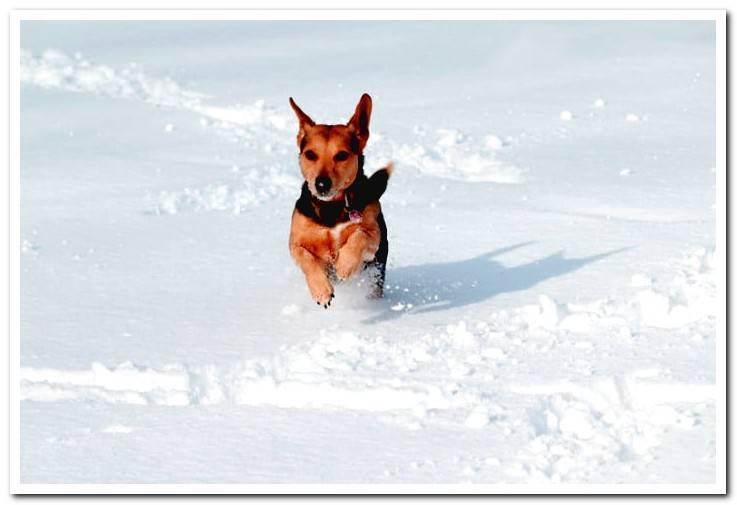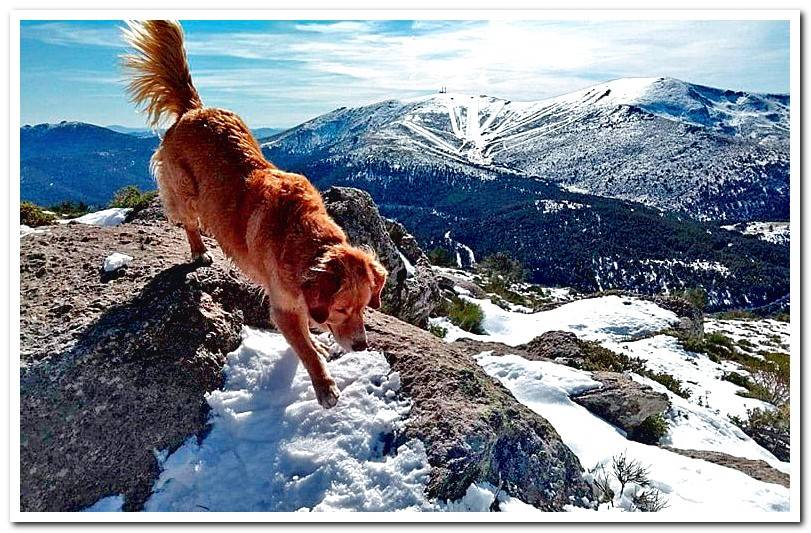
With the arrival of winter, getaways to the snow with our best friend are common. Therefore, we must not forget that this meteorological phenomenon can also cause severe damage to one of the most delicate parts of the body of dogs, their pads.
Index of contents
- 1 Dog pads problems from snow
- 2 Tips to avoid snow damage
- 3 What to do if my dog has suffered any of the consequences of the snow?
- 4 How to treat superficial cuts and wounds?
Dog pads problems from snow
- Freezing: The extreme body parts of dogs are the most prone to frostbite, such as pads, ears, and tail. Especially, the support surfaces are more likely to suffer frostbite due to direct and continuous contact with the snow.
- Burns: Not only the heat of the asphalt can cause burns on the pads of dogs, exposure to cold and moisture from the snow can also cause injuries like these in our dogs, as well as facilitate the appearance of cracks and friction.
- Cuts: The layer of snow that is created under our feet prevents us from seeing what is hidden under it, this can cause our dogs to suffer injuries to the pads, especially softened by moisture, when stepping on any glass or sharp material.
- Salt and antifreeze products: It is not uncommon to come across sidewalks or roads sprayed with salt or chemicals in places where it snows. These substances can irritate the bases of the paws of dogs, and what is worse, provoke intoxication after licking their paws.
- Snowballs between the fingers: in dogs that have a lot of hair between their fingers, it is common that, when walking, small snowballs are formed that prevent them from moving with agility.

Tips to avoid snow damage
Given their curiosity to discover new things, most dogs enjoy the snow, except for the coolest. However, we must take certain precautions to prevent what could be a great day in the snow from becoming a problem.
First of all, it is recommended, as with us, avoid the coldest hours. Depending on the breed, size, age and tolerance of the dog, we may also choose to provide them winter clothes to help you withstand the low temperatures.
Regarding the problems of freezing, burns, cracks and cuts in the pads, we recommend several preventive measures:
One of the most effective practices is to buy the animal some adjustable and special snow boots. These boots require an adaptation period, so wearing them at home first will be a good idea to get the dog used to it.
On the other hand, the application of petroleum jelly or creams help protect and strengthen this part of dogs. The use of balms suitable for your pH moisturize the pads of the dog and keeps them healthy, allowing the skin to be less prone to cuts and cracks.
As for the toxic products that are thrown on the street, boots would still be a good option. On the other hand, if our dog does not tolerate them, we should make sure to avoid the areas where we know there are these products and wash their paws well when returning from the walk.
In addition to being uncomfortable for the animal, the formation of balls between the fingers will increase the chances of freezing of the pads. To avoid them, you can trim the excess hair between the fingers and apply a little olive oil.

What to do if my dog has suffered any of the consequences of the snow?
If there is poisoning, a serious burn, a very deep wound that bleeds excessively, has an obstructed object or we have doubts about the severity of the problem, we should always go to the vet.
On the contrary, if it is a small cut or superficial burn, we can take care of it at home first and pay attention to its recovery.
How to treat minor freeze burns?
- Raise the temperature of the dog’s skin by moving it to a warm place and tucking it in.
- Wrap their legs with rags soaked in hot water (not boiling), changing them when their temperatures drop. It is very important that the temperature change is carried out gradually to avoid shocks.
- If residues remain in the burn after cleaning the area, they should be gently removed and the wound should be disinfected with a gauze pad with hydrogen peroxide.
- Under the veterinaryn’s approval, we can use a healing or moisturizing cream to calm and heal the affected area. These products must be suitable for dogs and free of alcohol or aromas, as this would worsen the situation.
You can also apply aloe vera cream or natural. This plant has moisturizing, regenerating, healing, antiseptic and analgesic properties that will promote a speedy recovery from burns and other injuries, such as cuts.
- As it is an area of direct contact with the ground exposed to friction and infections, the injury must be covered with a bandage. It is also recommended to protect the leg with a sock or shoe for greater protection when you go out.
- Clean the pad with saline and change the bandage two or three times a day.
- The tissues of the pad are slow to heal, so it must be ensured at all times that the pet does not lick the wound, being appropriate to use an Elizabethan collar if necessary.
- Regularly monitor the burn or wound to check its recovery. If it is not healing or improves, you should go to the vet.
How to treat superficial cuts and wounds?
1. Wash the wound with warm water and a suitable soap for its pH or hydrogen peroxide to disinfect.
2. Remove possible residues from the wound and assess the severity of the wound. If it is observed to be a deep cut, the wound should be pressed to stop the bleeding and go to the vet to check if you need stitches or other treatment.
3. Follow steps 4, 5, 6, 7 and 8 detailed above.
